
The Sycamore Historic District is a meandering area encompassing 99 acres (400,000 m2) of the land in and around the downtown of the DeKalb County, Illinois county seat, Sycamore. The area includes historic buildings and a number of historical and Victorian homes. Some significant structures are among those located within the Historic District including the DeKalb County Courthouse and the Sycamore Public Library. The district has been listed on the National Register of Historic Places since May 2, 1978.

The Guthrie Historic District (GHD) is a National Historic Landmark District encompassing the commercial core of Guthrie, Oklahoma, US. According to its National Historic Landmark Nomination it is roughly bounded by Oklahoma Avenue on the north, Broad Street on the east, Harrison Avenue on the south, and the railroad tracks on the west; it also includes 301 W. Harrison Avenue. The National Historic Landmarks Program on-line document describes the boundaries as "14th Street, College Avenue, Pine Street and Lincoln Avenue. One building, the Logan County Courthouse, is at 301 E. Harrison Avenue, outside the main boundaries of the GHD," This article relies on the former source, which is more detailed. According to the 1998 nomination, the proposed district covered 31 acres (13 ha). The nomination included 112 resources, classed as 69 contributing buildings, 38 non-contributing buildings, 1 non-contributing structure and 3 noncontributing objects. It was declared a National Historic Landmark in 1999 for its historic significance as the first capital of the Oklahoma Territory and of Oklahoma.

The Court House Hill–Downtown Historic District is a national historic district located in Lynchburg, Virginia. The area is situated on a promontory overlooking the Lower Basin Historic District on the south bank of the James River. The approximately 50-acre (200,000 m2) district is composed of relatively intact city blocks of religious, commercial, residential, and governmental buildings and structures ranging in date from the early 19th century to the mid-20th century. Buildings in the district represent a variety of styles from the different periods, including the Federal, Greek Revival, Gothic Revival, Italianate, Queen Anne, Neoclassical, Italian Renaissance, Spanish Eclectic, Craftsman, and Art Deco styles.

The Warsaw Courthouse Square Historic District is a historic district in Warsaw, Indiana that was listed on the National Register of Historic Places in 1982. Its boundaries were increased in 1993.
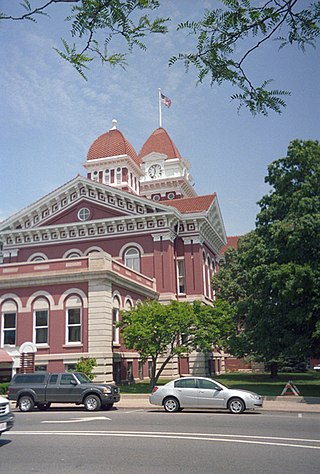
Crown Point Courthouse Square Historic District is a historic district in Crown Point, Indiana, that dates back to 1873. It was listed on the National Register of Historic Places in 2004. Its boundaries were changed in 2005, and it was increased in 2007 to include a Moderne architecture building at 208 Main Street. The late nineteenth- and early twentieth-century commercial and public buildings represent a period of economic and political growth. The Lake County Courthouse stands in the center of the district. Designed by architect John C. Cochrane in 1878, this brick building is a combination of Romanesque Revival and Classical styles. Enlarged in 1909 with the addition of north and south wings, designed by Beers and Beers. Continued growth in the county required second enlargement in 1928. This local landmark was placed in the National Register of Historic Places in 1973.

There are 75 properties listed on the National Register of Historic Places in Albany, New York, United States. Six are additionally designated as National Historic Landmarks (NHLs), the most of any city in the state after New York City. Another 14 are historic districts, for which 20 of the listings are also contributing properties. Two properties, both buildings, that had been listed in the past but have since been demolished have been delisted; one building that is also no longer extant remains listed.

The Silver City Historic District is a historically significant section of downtown Silver City, New Mexico, United States.

Valparaiso has retained an active downtown. It remains a mix of government, retail and business center, with a mixed residential and service area. Numerous economic changes have not changed the basic character, historic courthouse area. The historic district retains the distinctive turn-of-the-19th-century architecture, supporting numerous small specialty shops, shaded sidewalks, and a people friendly environment. The Downtown District, is anchored on the Porter County Courthouse. It includes 14-blocks surrounding the square, bounded on the north by Jefferson Street, on the east by Morgan Street, on the south by Monroe Street, and on the west by Napoleon Street.
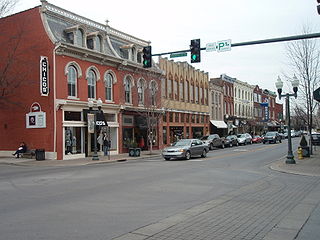
Franklin Historic District is a historic district in Franklin, Tennessee that was listed on the National Register of Historic Places in 1972. It was created to preserve historic commercial and residential architecture in a 16-block area of the original, downtown Franklin around the north, west, and south of the town square.

Sutton Downtown Historic District is a national historic district located at Sutton, Braxton County, West Virginia. It encompasses 85 contributing buildings and two contributing structures covering eleven square blocks. The district includes the commercial, ecclesiastical, and civic core of the town and surrounding residential area. The district includes a number of buildings representative of popular architectural styles from the late-19th century and early-20th century including Romanesque Revival, Colonial Revival, Gothic Revival, and Greek Revival. Notable buildings include the Braxton County Courthouse (1881-1882) and Jail (1905), Sutton Bank Building (1891), Farmers Bank and Trust (1909), Bank of Sutton, Methodist Episcopal Church, South (1896), Kelly / Fisher House. Elk / Midway Hotel (1894), and Katie B. Frame Residence. The two structures are the Bridge over Old Woman Run (1892) and Bridge over Elk (1930).

Luray Downtown Historic District is a national historic district located at Luray, Page County, Virginia. The district includes 75 contributing buildings, 1 contributing structure, and 3 contributing objects in the central business district of the town of Luray. They include residential, commercial, governmental, and institutional buildings in a variety of popular 19th and 20th century architectural styles. Notable buildings include the Skyline Building, Luray Motor Company (1935), Luray United Methodist Church (1899-1900), Luray Post Office (1938), Page County Record Building (1912), Bridge Theatre, Casey Jones Overall Factory (1922), Mansion Inn, Jordan-McKim Building, Hotel Laurance, and Mimslyn Inn (1930-1931). The contributing objects include the Confederate Monument (1918) and clock. Located in the district are the separately listed Luray Norfolk and Western Passenger Station and Page County Courthouse.
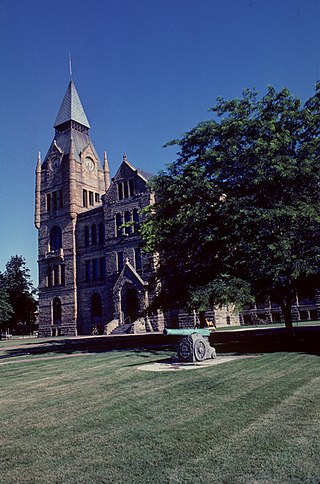
The Galesburg Historic District is a 496-acre (201 ha) historic district in Galesburg, Illinois. The district includes 1049 contributing buildings and contains the town's original plat as well as several older neighborhoods. The section of the district south of North Street encompasses Galesburg's historic city center and its most significant landmarks, such as the Knox County Courthouse, the Knox County Jail, the Burlington Depot, and Main Street's commercial buildings. Knox College, the school Galesburg was founded to serve, and its historic Old Main are also located in the southern half of the district. The area north of North Street is mainly residential and is dominated by Queen Anne and Classical Revival houses, including many transitional houses displaying elements of both styles.

Windsor Historic District is a national historic district located at Windsor, Bertie County, North Carolina. It encompasses 78 contributing buildings, 1 contributing site, 7 contributing structures, and 1 contributing object in the town of Windsor. It includes residential, commercial, and institutional buildings that primarily date after the turn of the 20th century. Notable buildings include the Bertie County Courthouse and Confederate Monument, Masonic Lodge, Spruill Building, J. B. Gillam House, St. Thomas Episcopal Church, and Cashie Baptist Church (1910).

The Dawson Street Residential Historic District, in Thomasville, Georgia, is a 200-acre (0.81 km2) historic district which was listed on the National Register of Historic Places in 1984. It then included 380 contributing buildings and three contributing sites.

The Yates Center Courthouse Square Historic District, in Yates Center in Woodson County, Kansas, is a 4 acres (1.6 ha) historic district which was listed on the National Register of Historic Places in 1986. The district included 33 contributing buildings and two contributing structures.
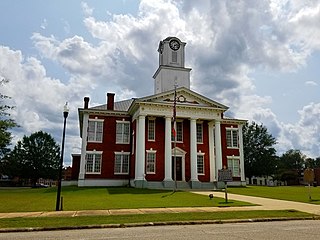
The Lumpkin Commercial Historic District in Lumpkin, Georgia is a 10 acres (4.0 ha) historic district which was listed on the National Register of Historic Places in 1982. The listing included 18 contributing buildings.

The Courthouse Square Historic District is a commercial and residential historic district, roughly bounded by Park, East Columbia, Rodgers and South Streets, in Mason, Michigan. It was listed on the National Register of Historic Places in 1985.
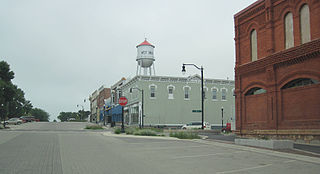
The West Union Commercial Historic District is a nationally recognized historic district located in West Union, Iowa, United States. It was listed on the National Register of Historic Places in 2015. At the time of its nomination the district consisted of 56 resources, including 38 contributing buildings, one contributing structure, and 17 noncontributing buildings. West Union was platted in 1850 and retail businesses began the same year around the public square. The square also served as the center for county government and as a place for many of the community's social activities. The wide streets and sidewalks in the central business district also facilitated the city's commercial and social life. The buildings in the district have housed various commercial businesses, government operations, and churches. The residential buildings are mostly associated with the churches. Most of the buildings are one and two-stories in height, although a couple are three-stories, and built of brick. Most of them are in the revival styles built in the Victorian era, including Italianate, Queen Anne, Neoclassical, and Colonial Revival. There are also buildings designed in the Commercial style. Several buildings were designed by architects, but for the most part the designers are unknown. The city's water tower is the contributing structure. The First Baptist Church (1867), Hobson Block (1885), Maple View Sanitarium (1903), and the Fayette County Courthouse (1923) are all individually listed on the National Register of Historic Places.

The Bisbee Historic District is located in Bisbee, Arizona, and has all the essential features of a prosperous, early twentieth century mining town.

The Downtown Paris Historic District, in Paris, Kentucky, in Bourbon County, Kentucky, is a historic district which was listed on the National Register of Historic Places in 1989.





















